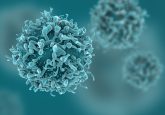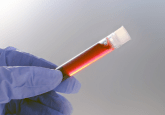Is a simple urine test the future of early lung cancer detection?
Researchers from Massachusetts Institute of Technology (MIT, MA, USA) have developed a urine test that can detect proteases associated with lung cancer. If successful, the nanoparticle-based test could reduce the quantity of false positives reported with current techniques and improve early lung cancer detection.
Annually, lung cancer kills approximately 150,000 people in the USA alone. At present, high risk individuals, such as smokers, have routine CT scans to identify tumors in the lungs. Unfortunately, CT scans often identify benign nodules. These false positives lead to large numbers of unnecessary and invasive tissue biopsies.
A team of scientists from MIT have aimed to address the limitations of CT scans by developing a nanoparticle-based urine test to aid in the detection of lung cancer. The research, published in Science Translational Medicine, indicates that the test – based on injected or inhaled nanoparticles – could detect tumors as small as 2.8 mm3 in mice.
Senior author, Sangeeta Bhatia (John and Dorothy Wilson Professor of Health Sciences and Technology and Electrical Engineering and Computer Science, Koch Institute for Integrative Cancer Research and Institute for Medical Engineering and Science) and her team have been developing nanoparticle-based tests for cancer detection for several years.
Interested in nanomedicine and nanotechnology?
Keep up with the latest news and research with our sister site The Nanomed Zone. Learn more
The tests utilize nanoparticles coated with peptides that are targeted by cancer associated proteases. As the nanoparticles accumulate at the tumor site, peptides are cleaved to release biomarkers which can then be detected in a urine sample.
To design sensors for lung cancer, Bhatia’s team used the Cancer Genome Atlas to identify proteases abundant in lung cancer. With target proteases identified, the team created 14 peptide-coated nanoparticles.
Using two different mouse models of cancer, the team investigated the performance of the nanoparticles in the diagnostic urine test at 5 weeks, 7.5 weeks and 10.5 weeks after tumor growth began. The team used machine learning to develop an algorithm to better distinguish data from mice with tumors and mice without.
Using this, the scientists reported success rates for the urine test comparable to, or better than, CT scans at the same time points. The urine test detected 2.8 mm3-sized tumors at 7.5 weeks and also at 5 weeks in another strain of mice.
Importantly, the urine test may be capable of reducing the number of false positives. The nanoparticle sensors can distinguish early-stage cancer from noncancerous lung tissue inflammation. In the future the urine test could also be used to monitor tumor response to treatment.
Bhatia explained: “A great next step would be to take this into patients who have known cancer, and are being treated, to see if they’re on the right medicine.”
Sources: Kirkpatrick JD, Warren AD, Soleimany AP et al. Urinary detection of lung cancer in mice via noninvasive pulmonary protease profiling. Sci. Transl. Med. doi:10.1126/scitranslmed.aaw0262 (2020)(Epub ahead of print); http://news.mit.edu/2020/urine-sensor-test-detect-lung-tumors-0401






